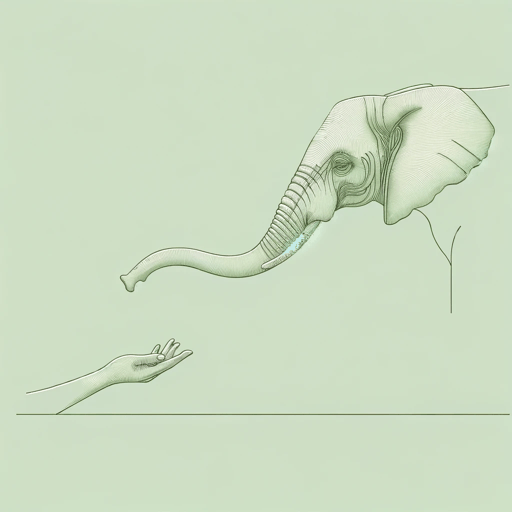65 pages • 2 hours read
Lawrence AnthonyThe Elephant Whisperer
Nonfiction | Autobiography / Memoir | Adult | Published in 1999A modern alternative to SparkNotes and CliffsNotes, SuperSummary offers high-quality Study Guides with detailed chapter summaries and analysis of major themes, characters, and more.
Summary and Study Guide
Overview
The Elephant Whisperer: My Life With the Herd in the African Wild (2009) is a memoir by Lawrence Anthony, detailing his experiences with rehabilitating a traumatized herd of elephants on his game reserve in South Africa. The book explores themes of bonding and communicating with animals, the inherent interconnectedness of nature, and the challenges of conservation efforts.
Anthony was an internationally renowned conservationist and environmentalist. He was the co-owner and head of conservation at the Thula Thula game reserve in Zululand, South Africa, where the book is set, as well as founder of The Earth Organization. Anthony’s work with animals has received global acclaim and fame, particularly his efforts in saving the animals of the Baghdad Zoo following the American invasion of Iraq in 2003. This experience was the first to find its way into an award-winning book, titled Babylon’s Ark: The Incredible Wartime Rescue of the Baghdad Zoo (2007). The Elephant Whisperer is Anthony’s second book, and his third, The Last Rhinos (2012), was published a few days after he passed away.
This study guide is based on the Pan Macmillan Kindle Edition.
Summary
Lawrence Anthony runs a reserve called Thula Thula in Zululand, South Africa, and is asked to take on a herd of wild elephants with a difficult past. They have broken out of their prior homes numerous times and have been deemed unruly and dangerous. Lawrence agrees despite some apprehensions, as he is also dealing with a poaching problem on the reserve. The herd breaks out of the reserve on their very first night, and Lawrence later learns that there were gunshots outside the boma, the holding pen in which the herd was quarantined. The herd makes its way to the nearby Umfolozi reserve, where they are captured and brought back to Thula Thula. However, Lawrence is warned by KwaZulu-Natal Wildlife that if the herd breaks out again, they will be put down.
Lawrence decides to adopt uncommon methods to rehabilitate the traumatized and mistrustful elephants: He begins to live with them outside the boma. Over time, he forges a connection with the matriarch of the herd, Nana, who begins to trust him. Following an incident where Nana approaches Lawrence at the fence and touches him with her trunk, he decides the herd is ready to be let out of the boma and onto the reserve.
The day the herd is let out, Lawrence receives news that Ndonga, the head of his Ovambo guards, is responsible for the poaching on the reserve. Lawrence remembers a series of mishaps that occurred in the process of getting the reserve ready for the elephants. Shortly after the elephants exit the boma, they are discovered at the northern boundary of the reserve trying to topple a tree onto the fence, despite Ndongo’s assurances that all the trees near the boundaries have been felled. Convinced of Ndonga’s guilt, Lawrence and his rangers gather information and evidence from witnesses who come forward and build a case against the Ovambos, but they flee before the police can arrest them. Nevertheless, with the large-scale poaching problem resolved, the reserve begins to find some equilibrium.
Lawrence spends time with the herd in the bush, first in his car and then on foot, acclimatizing them to the presence of the humans around them. Over time, the herd reciprocates, often coming up to the house to visit Lawrence. Lawrence observes and reflects on the animals’ superior communication abilities, remarkable intellect, and capacity for compassion. These are displayed through instances when Nana and Frankie, the second-in-command of the herd, bring their newborn calves to meet Lawrence. Similarly, when a single female elephant, ET, is introduced to the reserve and included in the herd, Nana and Frankie come to Lawrence’s rescue on multiple occasions when ET charges at him, breaking ET’s charges and saving Lawrence’s life.
Eventually, the herd grows in size, to Lawrence’s delight. He also experiences heartbreak when Mnumzane, a young bull from the original herd, matures into an alpha and inexplicably turns ill-tempered and dangerous. Mnumzane subsequently has to be put down.
Alongside Lawrence’s rehabilitation of the elephants, he works on a conservation project that sees lands belonging to different Zulu tribes being leased to a single trust, the Royal Zulu, to be used for conservation. Lawrence faces obstacles along the way, as some cattle owners resent the project and attempt to cause trouble by harming Lawrence’s relationship with the principal chief in the area, Nkosi Biyela. When this fails, they plan on assassinating Lawrence. Lawrence manages to prove his loyalty to the Nkosi, as well as confront and gather assurance from the tribal headmen that he will not be harmed. Eventually, the project sees a fundamental breakthrough when the Nkosi promises to join all the land in his power with Lawrence’s for the Royal Zulu project.
Throughout the narration, Lawrence also details smaller incidents and experiences on Thula Thula, from dealing with poachers to encounters with lions, crocodiles, snakes, and other wildlife. Additionally woven in are explorations of the culture and traditions of the Zulus and Lawrence’s own brushes with the supernatural, which is a way of life in Zulu society. The book ends with Lawrence returning from a six-month stint in war-torn Baghdad, where he works to save the animals in the crumbling Baghdad Zoo. This leads him to pen Babylon’s Ark, set up The Earth Organization, and reflect on the lessons he has learned from the herd.

